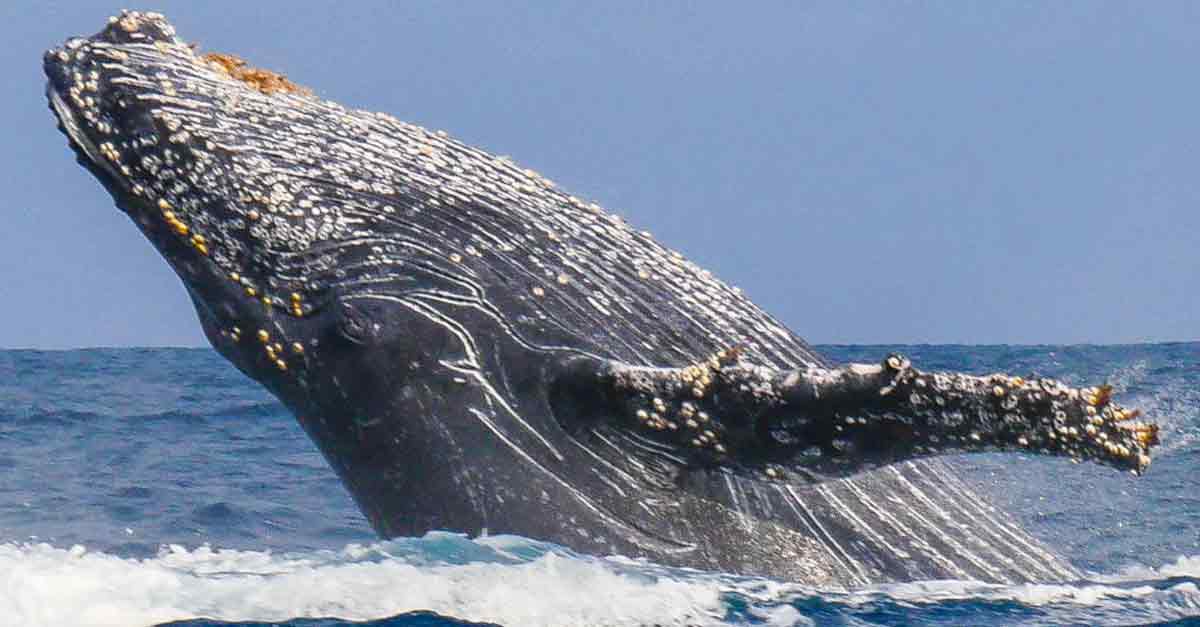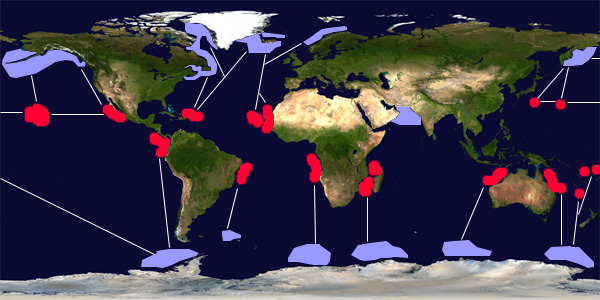The humpback whales in Madagascar

Whales have always been present in Madagascar, but it is only for a few decades that we are interested. Currently 5 different whale fields have been identified while only 3 have been confirmed visually, including the Omura Whale in 2015. The first to be identified is the humpback whale because the most demonstrative, which can be easily observed at Nosy Be during a whale safari
What does a humpback whale look like?
The humpback whale (Megaptera novaengliae) has a black or dark gray back with a hump in front of the dorsal fin, two large pectoral fins that are one-third of its length (hence the name of humpback) and a caudal fin whose underside has white spots peculiar to each. This caudal footprint and the equivalent of our fingerprint and thus allows to identify it.
It is 12 to 16 meters long and weighs 25 to 40 tons. As a mammal, she must breathe with her lungs, which forces her to come to the surface every quarter of an hour for our greatest pleasure! The adult can stay 40 minutes under water. Offshore, its caudal fin rises vertically above the water and its breath (up to 3 meters) is as high as it is wide. Despite her size, she performs very beautiful acrobatics and often jumps out of the water during parades.
Best Places to Go Whale Watching in Madagascar
 Before coming to Nosy Be, they go through Nosy Boraha. It is the first place where humpback whales land to give birth to their calves because the area of Sainte Marie and Madagascar is a natural deep bay without predators, therefore an ideal place for reproduction. If you go through Sainte Marie, you might be lucky enough to witness a birth!
Before coming to Nosy Be, they go through Nosy Boraha. It is the first place where humpback whales land to give birth to their calves because the area of Sainte Marie and Madagascar is a natural deep bay without predators, therefore an ideal place for reproduction. If you go through Sainte Marie, you might be lucky enough to witness a birth!
Sainte Marie Island, off the east coast of Madagascar, is the ideal place to observe the humpback whales that visit the area from June to September. Not only is it a paradise of white sandy beaches and flippers, as well as the location of a pirate graveyard dating back hundreds of years, but also a unique position as a refuge for humpback whales that call the narrow channel between St. Marie Island and Madagascar their home during this period. Travellers can easily spot the cetaceans from the coast or venture out by boat with a responsible and conservation-oriented company to see the whales breaching and tail banging all around them.
Whales are fascinating creatures, their impressive size and mysterious habits have earned them legendary status among marine mammals. Madagascar is a fantastic place to observe these great giants of the deep. From June to September, large numbers of humpback whales travel to Madagascar’s warm waters to breed, calve and make a spectacle of breaching and splashing just offshore. They then migrate around the island following a precise route before returning to the cold waters of Antarctica. Other marine giants such as whale sharks can be found all year round, you just need to know where to look…
Groups of whales migrating from Antarctica split in two when they reach Madagascar, which means that a certain percentage of the group heads for Ifaty, in the northwestern region of the island, instead of Sainte-Marie Island. They are there during the same period and for the same purpose. If your itinerary takes you to this side of Madagascar, you too will have the opportunity to observe groups of whales by the hundreds.
As the whales move around the island with their calves, they can be observed from Tsarabanjina and Nosy Be, on the western part of the island, from August to November. Nosy Be is also a fantastic place to see and even swim with whale sharks, which are not really whales but, as the biggest fish in the sea, are of the same size and nature. Nosy Be is well known for its excellent snorkeling and diving conditions. As whale sharks are generally placid creatures that only eat plankton, it is possible to swim practically next to them underwater, of course it is forbidden to touch or disturb them.
The area around Nosy Be, including Nosy Iranja, is also the place where an incredibly rare species of whale, the Omura whale, has been seen in the largest group ever discovered. A group of 80 whales, including calves, were found here in 2016 and are believed to reside in the area, which is incredibly interesting for marine biologists who have established research centres in the area.
Whale watchers visiting Madagascar will be delighted. This island nation, well known for its extraordinary wildlife on land, also offers incredible opportunities for marine wildlife viewing and nature lovers will certainly not go away disappointed.
After Sainte Marie, the humpback whales continue their ascent to Nosy Be where they will spend 2 months and teach their calves to jump. With a bit of luck, you will have the opportunity from the beach to see a whale in the distance make a magnificent jump and then to see the calf try 3-4 times, and the mother showing her calf and this one reassuringly more beautiful, this for a good thirty minutes until you lose them. An unforgettable spectacle.
After these two months, in September, they leave again for the South Pol, but don’t worry, the whale sharks come to visit us in their turn!
Whales in the territory of Nosy Be
We can not really know when the whale was seen for the first time in Nosy Be. Is it since its existence, since climate change or just since it was hunted by men? All we know is that every year the cetacean makes its usual journey from the South Pole to the Indian Ocean. She first goes through Sainte-Marie to give birth and Nosy Be to mate with other congeners.
On the plus side, whales are respected by local fishermen. Nobody chases her or disturbs her, her species finds tranquility and does not risk, (at least until now) to be taken to the assaults by the whalers. It is perhaps for this reason that this great mammal travels every year in the deep waters of Nosy Be.
To see it, you must go to the bay of Ampasindava where the whale cohabitates in peace with other fish. But maybe she’s the one who will find you first, sociable, she likes to be the center of attention, which does not displease the audience.
He migration of humpback whales around the world

Each year the humpback whale establishes its usual life cycle. In summer, she lives in the icy waters of the Arctic and Antarctica to feed herself in abundance. In winter, she will move closer to Ecuador in warmer waters for the mating season.
From December to the end of April, humpback whales are found mostly in Antarctica, south of Cape Horn, more than 8000 km from Mayotte and Madagascar, but also in Greenland, off Quebec. During this period, they make fat reserves by feeding in large quantities mainly krill (small shrimps), herring, capelin, sand eels and mackerel. They make reservations because later they do not feed for six months.
The migration starts from the end of April to finish in June, they travel from Antarctica to the waters of the Indian Ocean, up the coasts of South Africa to the East, off the coast of Colombia and by the Mozambique Canal to reach further west to Comoros and Mayotte or head north-east of Madagascar, to the island of St. Mary, Antongil Bay and Nosy Be.
Another group, still from Antarctica, will head straight to the West of the tip of Africa, on the Atlantic side towards Gabon (Mayumba, Gulf of Guinea, towards the waters of Sao Tome and Principe) and the Cameroonian, Nigerian or Ghanaian coasts.
Those from Greenland and those off Quebec will head to the Caribbean.
From July to the end of October they can be seen in the warm waters of the Indian Ocean and in Mayotte (= hot waters of more than 26 °), where they come to breed, some as far as Réunion, Seychelles and Mauritius. The peak of observation is in August.
Once abundant in the South Pacific: New Caledonia, Tonga, Cook Islands, French Polynesia, Vanuatu, Fiji, Samoa, American Samoa and New Zealand, humpback whales have long been hunted in Polynesia. Reduced to less than 5% of their original size, only very young populations are now found in Ruturu and generally around the Society Islands, Austral Islands and Tuamotu Islands in October.
Whaling, a period that ended thousands of cetaceans
The whaling, a doctrine that has existed since the tenth century, was on the one hand a survival for men, but also a quick way to get rich. The latter hunted whales for their oil, but also for everything that concerns them (carcass, intestine, …).
Whale oil has many uses, namely heating and lighting, for example a blue whale 26 meters long produces more than 20 tons of oil. If at first the remains of the cetacean were left behind, the men found a way to use them to their advantage. Thus the carcass served as material, the leather for the belts or the intestines dried to design ropes.
Whaling lasted nearly 10 centuries, the bloodiest period of which was between the 19th and 20th centuries. Until today, this doctrine still exists but it is very discreet having become illegal.
Whale protection, no hunting
Commercial whaling is prohibited by the International Whaling Commission (IWC). This law introduced in 1986 is applied in favor of the humpback whale and other cetaceans of the same branches. This regime, although universal and enforced by all, is bypassed by some countries, including Japan, Norway and Iceland, which do not accept this convention. Several associations such as Seashepherd are still fighting to defend them.
In the territory of the Indian Ocean, this ethics is quite respected. So far, we have not heard of whaling in the waters of Nosy Be. On the other hand, scientific expeditions are now open to all those wishing to know the whereabouts and whales.
Note that the whales visible in Nosy Be are all protected. During your stay you can meet some species of cetaceans including the best known, the humpback whale that is present between July and September, but also the whale of Omura, Bryde’s whale or the whale shark.
